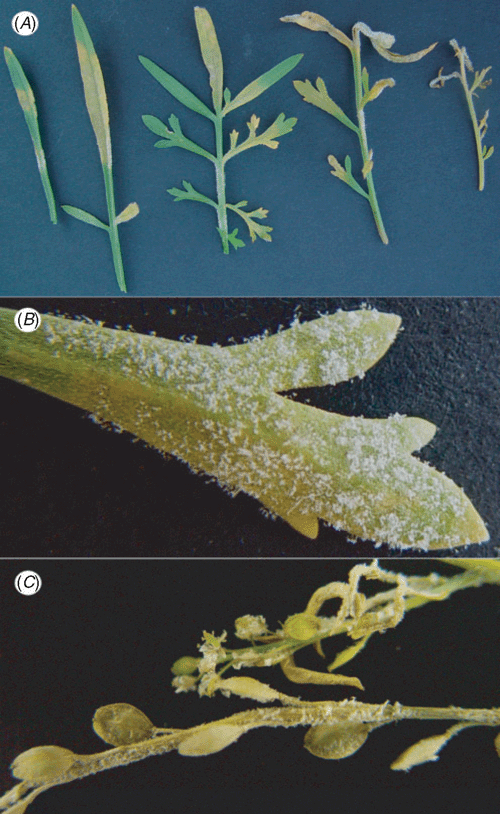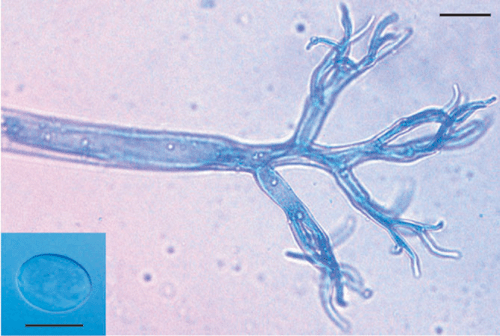First report of downy mildew on Lepidium sativum in India
Kunal Mandal A , Prakash R. Patel B and Satyabrata Maiti A CA National Research Centre for Medicinal and Aromatic Plants, Boriavi, Anand, Gujarat 387310, India.
B Department of Biosciences, Sardar Patel University, V.V. Nagar, Anand, Gujarat 388120, India.
C Corresponding author. Email: satyabratamaiti@hotmail.com
Australasian Plant Disease Notes 3(1) 73-74 https://doi.org/10.1071/DN08029
Submitted: 20 April 2008 Accepted: 16 May 2008 Published: 5 June 2008
Abstract
Downy mildew caused by Hyaloperonospora parasitica on different members of Brassicaceae has been reported from different parts of the world. In India, the pathogen is recorded for the first time on Lepidium sativum. Proper management strategies need to be formulated against this disease as incidence is increasing.
Garden cress (Lepidium sativum) is grown as a minor crop in western states of India. Leaves are used for salad or cooked as vegetables. It has medicinal properties as well. It is used in asthma, coughs and bleeding piles (Anonymous 1998). Dry herbage is used as fodder. Traditional sweets for lactating mothers are prepared from the seeds. Seeds are also used as animal feed to improve the milk yield. The crop produces reasonably good yield even with minimum irrigation. This encourages the farmers from the drier western India to grow this crop and cultivation is spreading. Downy mildew was first noticed a few years ago in research plots, where it was of minor importance. More recently with higher humidity and dew deposition, the disease has spread to a wider area and now occurs not only on the foliage, but also the flowers and fruits.
The disease was first observed during February 2005 at the research farm of the National Research Centre for Medicinal and Aromatic Plants, Anand, Gujarat, India. Initial visible symptoms were slight discolouration of the upper lamina. Later, large portions of the leaf showed well-defined yellow spots. The corresponding lower surface of the leaf showed typical white downy growth (Fig. 1). Under severe infection, downy growth was also observed on the upper surface of the leaves. Infections were also noticed on the stems, peduncles and fruits (Fig. 1).

|
Usually downy mildew symptoms were scattered on the leaf while dense on the stem. Asexual reproductive parts were typical of Peronosporales with tree-like, colourless, stout, straight conidiophores, 128–434.5 μm long; branching started 49–217 μm from base (Fig. 2). Conidiophores usually branched four times, with branching being monopodial in 2–3 orders and first order branches always alternating. The ultimate branchlets were 9–27 μm long, bearing single conidia. These paired branchlets were produced in acute angles, typically recurved. Conidia were colourless, subglobose to ovoidal, to broadly ellipsoidal, 15.5–29 × 13–22 μm. Maximum widths were median or submedian, base and tip were round and conidia walls were smooth when viewed under light microscope (Fig. 2). The fungus has been identified as Hyaloperonospora parasitica. Samples were deposited at the herbarium of the Department of Plant Pathology, IARI, New Delhi (HCIO 48122) and Uppsala University, Sweden (UPS F-127515).

|
H. parasitica has a wide host range and a worldwide distribution. The disease has been reported earlier from different countries (Constantinescu and Fatehi 2002 and references therein). Downy mildew on many Brassicaceae (Bains and Jhooty 1983; Singh and Kolte 1999) has been reported from India. However, this is the first report of downy mildew caused by H. parasitica on L. sativum.
Acknowledgements
We are grateful to Dr O. Constantinescu, Uppsala University, Sweden for confirming the identity of the pathogen.
Bains SS, Jhooty JS
(1983) Host range and morphology of Peronospora parasitica from different sources. Indian Journal of Mycology and Plant Pathology 13, 372–375.

Constantinescu O, Fatehi J
(2002) Peronospora-like fungi (Chromista, Peronosporales) parasitic on Brassicaceae and related hosts. Nova Hedwigia 74, 291–338.
| Crossref | GoogleScholarGoogle Scholar |

Singh MP, Kolte SJ
(1999) Differential reactions of various crucifer host species against isolates of Peronospora parasitica. Journal of Mycology and Plant Pathology 29, 118–121.



